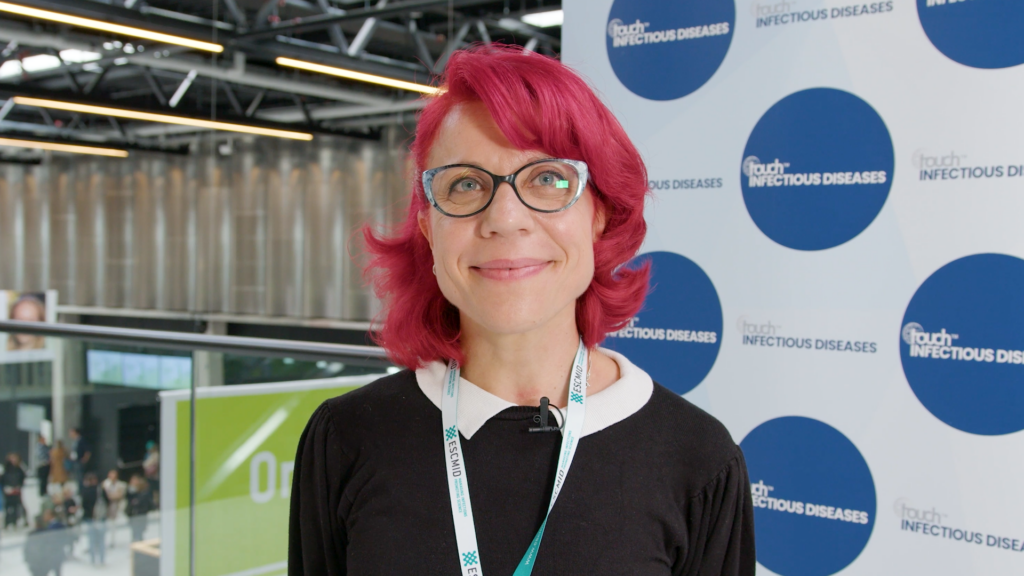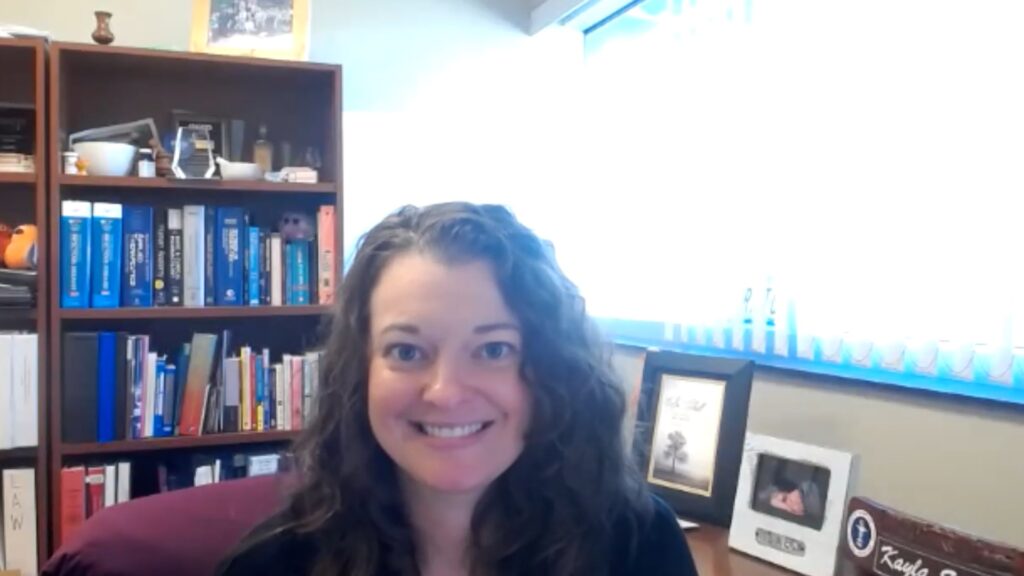Multidrug resistance (MDR) is a significant public health concern, leading to increased hospital stays, higher healthcare costs, and increased mortality rates. The overuse and misuse of antibiotics are major contributors to the development of MDR.
We met with Dr Grace Salazar Tamayo (Hospital General Dr Manuel Gea González, Mexico City, Mexico) to discuss a retrospective comparative study investigating whether there was a decrease in the number of new isolates of carbapenem-resistant Enterobacteriaceae (CRE) strains, conducted in a second level hospital in Quito – Ecuador. Dr Salaxar also discusses how hospital authorities and healthcare providers can collaborate to prevent MDR in patients, remaining unanswered questions, and future studies.
The abstract ‘How to avoid multidrug resistance (MDR)? Successful experience with the application of a hospital bundle (HB).’ (Abstract number: O1112) was presented at ECCMID 2023, 15-18 April, 2023, Copenhagen, Denmark.
Questions:
- What are some of the major causes of MDR in your country or environment and what challenges did healthcare professionals face during the phase IIb study? (0:15)
- What are the aims, design, and eligibility criteria of your study? (2:15)
- What were the key findings, and what will be their implication in clinical practice? (6:15)
- Based on these findings, how can hospital authorities and healthcare providers work towards preventing MDR in patients? (8:14)
- What questions remain unanswered and what future studies are planned? (9:57)
Disclosures: Grace Salazar Tamayo has nothing to disclose in relation to this video interview.
Support: Interview and filming supported by Touch Medical Media Ltd. Interview conducted by Katey Gabrysch and Victoria Jones.
Filmed in coverage of the 33rd European Congress of Clinical Microbiology & Infectious Diseases.
Click here for more content on antimicrobial resistance & for further ECCMID 2023 highlights visit here.
Transcript
What are some of the major causes of MDR in your country or environment and what challenges did healthcare professionals face during the phase IIb study? (0:15)
Ecuador is a middle-income country, in the setting of the control of multidrug resistance, of course, are the same as in other countries, but in like an appropriated use of antibiotics, lack of clean and disinfection in hospitals, lack of visitation of colonized patient and others. But this is aggravated by other circumstances, such as the poor health conditions in my country, the continued lack of access to adequate health services in the country, and the poverty, a lack of health personnel, of training in infection control, lack of national control of antibiotics, for example, in both in their use and control of antibiotics, in pharmacies, sales and other things. A public hospital doesn’t have national accreditations policies. Neither object is clear is in the infection control processes and in general, these measures are reduced to isolated activities in the medical environment that for a global health personnel are new and in fact, the most trouble faced during the study is from authorities the cleaning and disinfection. The step was difficult to understand the reason for implementing strategies for CRC control and we observe during the intervention that younger personnel have better attitude for acquired new knowledge in training about infection control. Understanding the benefits for implementation. These measures for improving outcomes with patients but older people was more difficult to convince of change.
What are the aims, design, and eligibility criteria of your study? (2:15)
The main objective of the study was to evaluate if there was a decrease in the number of new CRE isolates in hospitalized patients with a prolonged, unsupervised application of five measures that we call the hospital bundle. These measures included one full management support for all decisions related to infection control, because in Ecuador there are no nationwide regulations to support infection committees in the hospitals and for this reason, this may or may not be given. Depending on the monitoring it saw with a change of management and after a meeting with infection control committee in which the importance of CRE control was determined, policy for decisions related to control in CRE was approved. The second measure was implementation and application of line observation of hand hygiene because prior to intervention, all personnel knew the hand hygiene observers and for this reason, the rate of adherence to hand hygiene was incredibly high and the intervention was carried out blindly. Monthly evaluations with a simple free cell phone program. The infection control committee disseminated the data to sensitized health personnel and carried out some routine campaigns with incentives favours of hand hygiene. The third intervention was remotely supervision of the cleaning and disinfection process by personnel of the infection committee, cleaning staff and hospital leaders. These operations consisted of reviewing for cleanliness, of surfaces with alcohol wipes, and analysed the whole process from the mixture of disinfectants and the correct steps in the process and the correct use of the wipes, and the application of the basic principles of the cleaning and disinfection in hospitals, and in order to carry out corrections as needed. Sometimes we could use the bioluminescence when it was available. Also training in the sample and in the process was in the other measure was improved the detection of the patients to have better idea to the local epidemiology. In Ecuador, the mandatory reporting is limited to ventilator associated pneumonia, catheter related bacteremia and urinary tract infections and surgical site infections only in intensive care patients. During the study, the infection control committee established the search for these and supplemental infection Clostridium and all nosocomial infections we looked at and for reviewing clinical records during the hospitalization and discharge. The last measure was the application of our restrictive antibiotic control program applied to carbapenems, glucopeptides and other antibiotics which could only be dispatched from the pharmacy after the authorization of the IED consultant. These processes were communicated via WhatsApp chat. So it is 5 measures. We carried out a retrospective comparative study in two periods of time the period a of a year without interventions and the period b will be two years with the hospital model. Then we compared the CRE rates and nosocomial infections, the consumption of antibiotics and the percentages and occurrences of hand hygiene in the two periods.
What were the key findings, and what will be their implication in clinical practice? (6:15)
With the application we observe a decrease in the CRE rates from 0.59 in period a to 0.18 cases per 1,000 patient days in period b. We calculate our ratio for acquired CRE in the two periods it’s 3.6 versus 0.2. During the interpretation we realize some interesting things too like one: health personnel were greatly impacted, seeing the authority 100% committed to these measures and being part of the trainees and campaigns, so a management support is essential in these measures. Also, since blind observation was applied, real adherence to hand hygiene or we apply protective measures, positive stimuli campaigns and trainings to increase adherence. These percentages had an indirect relationship with nosocomial infections. Another observation was that healthcare associated infections increases because of increased report and investigation. This was appropriate for evaluate and the epidemiological/ local epidemiology, their restrictive antibiotic were significantly lower in period b, but without association with their rate of CRE isolates. More important was the increase of the global antibiotic use in the intervention periods. These showed that the antibiotic stewardship must be educational too not only restrictive. Regarding cleaning and disinfection, we don’t need great analysis for surveillance, but the important thing of this intervention was to carry it out continuously and this help to clean this stuff to improve their process.
Based on these findings, how can hospital authorities and healthcare providers work towards preventing MDR in patients? (8:14)
We think for a decrease in multi-drug resistance in hospitals, management accountability during the application of the measures is needed at the beginning and the support must include all components economic with personnel and administrative, depending on the hospital needs and before an evaluation in each hospital setting, the personnel related to infection control, must continuously assess the preventive measures, analyze them and in front of health personnel, identify the problems and seek solutions in a positive way, including all the participants in the review of the patients. These processes must be cyclical and permanent and to give the hospital community information about outbreaks, alerts, jobs in hand hygiene and problems in cleaning and disinfections and their corrective measures create an environment of trust and motivates many people to collaborate with the measures.
What questions remain unanswered and what future studies are planned? (9:57)
Based on the results of this study, I would like to know if any of these measures have more influence than another in the control of resistance, of course. In addition, knowing that the researchers are on control is not only a tool to a small group of infection surveillance, but also implies the commitment of all those related in patient care. It seems to me very important to determine what the attitudinal factors are included psychological that make one or other person participate more than another. In the future, I hope, I would like to apply this hospital bundle in other hospitals in the area and see the results are reproducible.
Subtitles and transcript are autogenerated.








